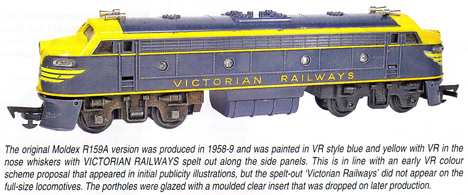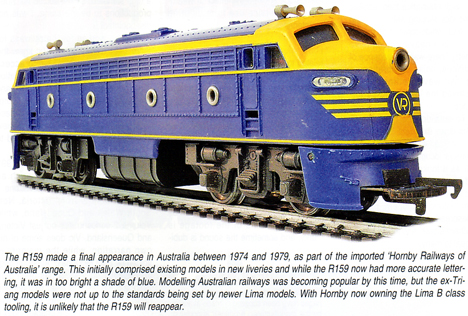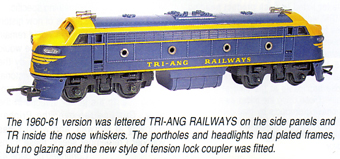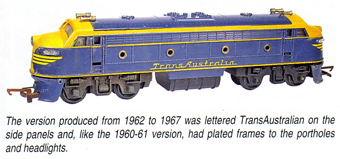Article
Retro Review - Tri-ang Double-ended Diesel (R159A) In OO/HO Scale
Author: Graeme Brown
Date: 8 November 2009
Related Model: Double-ended Diesel Locomotive (VICTORIAN RAILWAYS) (Aust)
* This article originally featured in the April 2008 edition of the Australian MODEL RAILWAY Magazine.
Tri-ang Double-ended Diesel (R159A) in OO/HO scale. Produced by Tri-ang’s subsidiary, Moldex, between 1959 and 1967. Current prices in text.
In 1952 the Victorian Railways introduced their first class of mainline diesel-electric locomotive. This was the Clyde-GM Model ML2 which became the VR B class, numbered 60 to 85. These locomotives rapidly replaced the aging S class steam locomotives in VR publicity material and thus became well known to the general public.
The first mass produced model appeared quickly with the Sydney firm of Ferris introducing an O gauge tinplate model loosely based on the B class in 1953. Small numbers of O (1:48) scale models were also built by Alan Shorter and sold under the Phoenix Model Co. name from 1954.
In 1956, the Lines Group of British toymakers was expanding into the Australian market and bought Moldex Ltd., a manufacturer of plastic goods, including toys, located in the Melbourne suburb of Fairfield. This was seen as a way to avoid the tariff barriers against importing goods into Australia at the time and Moldex was to become the local manufacturing base for the Tri-ang Railways range of OO/HO model trains, previously imported from the UK.
As part of the entry into the Australian model railway market, the main Tri-ang Railways factory at Margate designed and tooled up a new model in their Transcontinental range, which was based on the VR B class. A set of these tools was sent to Moldex and production began in 1958. These tools were also used in New Zealand for local production.
Between 1958 and cessation of rolling stock production at Moldex in 1967, the factory at Fairfield turned out 30,100 R159A models. The same tooling was also used to produce 600 R250A dummy locomotives and 200 R257A overhead electric locomotives. The model also proved popular in the UK and some 120,000 were made there between 1958 and 1966. The reason for its popularity in the UK was believed to be the colour scheme and Tri-ang used the blue for several subsequent models also sold well.
After Moldex stopped production in 1967, the R159 remained available in Australia as fully imported models from the UK. Production finally stopped in 1979, by which time the company had changed name to Hornby Railways.
As with any Tri-ang model of the 1950s, it was intended as a toy, not a scale model. Consequently, while it is obviously based on the VR B Class, it is not particularly accurate. The scale is quoted as OO/HO, but in the 1950s there were several HO scales in use and Tri-ang seem to have used the larger 1:83 (3.8mm/foot) scale for their TC range. The major appearance problem is the bogies. Tri-ang were masters at reducing production costs and one of the methods was to use as many common parts as possible. At the time they did not make a six-wheel power bogie, so the model was fitted with the standard MkIIC four-wheel power bogie used on the other diesels in the Transcontinental range. The model was fitted with headlights at each end, but before the days of miniature solid state electronics, these were non-reversing.
The weight of the model is about 200g and the tractive effort is about 50g on Tri-ang track, which is reasonable, even by modern standards, especially as only one bogie is driven. The power bogie is fitted with knurled wheels to help traction. As with any model with only one bogie powered, it will pull a longer train if the power bogie is at the rear, as this reduces weight transfer and tipping of the bogie. Contemporary Tri-ang rolling stock had plain bearings and rolled like a brick, but an R159 could usually pull for bogie coaches/wagons, or eight four-wheel wagons on a typical Tri-ang layout of the period. Fit one with two power bogies, which is allowed for in the body design, and it will out pull just about any modern model.
Like all Tri-ang mechanisms of the time, the power bogie is well designed, strongly built and easily maintained. Tri-ang frequently cut corners to reduce the price of a model, but that did not extend to the mechanism until much later. Unlike modern models, any part could be easily obtained from any dealer and there was a worldwide network of service agents.
With a transistor control, either a modern one or the contemporary Moldex P5T, the model is quite controllable, starting at about 4V and with typical Tri-ang 13:1 gearing, reaching liftoff speed at around 12V. Scale speed is hard to calculate, given that the scale of the model is debatable, but speed at 12V would be well over the scale ton. Old Tri-ang resistance controllers, give poor low speed control and best avoided.
Tri-ang and Hornby have always used their own track and wheel standards, with older models having very deep flanges and a narrow back-to-back. Early non-driven wheels had sleeved axles and could move in and out on the axle to some extent. The model was introduced when Tri-ang were changing from the grey Standard track to the black Series 3 track and remained in production through Super 4 track, System 6 track and early Hornby track. Consequently, the R159 will run on any Tri-ang or Hornby made track, including modern Hornby track. Some of the later ones, made from late 60s on, will run on Peco setrack and older Peco Code 100 Streamline.
The R159 colour scheme was generally a shade of dark blue and yellow in the VR style, although New Zealand models were commonly plain red and the blue NZ ones did not have the yellow trim. At the time Tri-ang did not use prototype liveries for the TC range and Australian-made R159A models are lettered Victorian Railways, Tri-ang Railways or TransAustralia.
Over the 21 year production run, there were three main variations produced by Moldex in Australia, two by Tri-ang Pedigree in New Zealand and six by the Rovex factory in the UK. Minor colour variations, transfer differences and factory mistakes would at least double that. The most common Australian variation is probably the 1962-67 TransAustralia version. The UK made 1962-72 version with TC shields would be the most common version of all and the rarest may be the 1959 version in dark green and yellow, made in the UK and sold only in a special set for Canada.
So many were made that the common versions are still easy to find on eBay, at swap meets and second-hand tables at exhibitions in Australia. Most are well worn, with the common missing bits being the cowcatchers, fuel tanks and the transfers on the nose. Most will still run, especially with a good clean and oil. Non-runners can sometimes be repaired, or can be used as a source for parts. Some mechanical parts like motor brushes are still available from specialist suppliers, as are some body parts for restoration work.
In Australia prices run from around $40.00 for a well worn one, up to $200.00+ for a good boxed one. Rare versions can go higher, so plan on spending a lot more if you want the green Canadian version.
Anyone wanting more information on Tri-ang Railways is referred to The Story of Rovex, Vol.1 1950-1965 by Pat Hammond, New Cavendish Library, Revised Edition, 2001, which is still in print.
Historically these models are important on several counts. They were the first mass-produced HO model of an Australian locomotive, one of the few actually made in Australia and almost certainly the only model of an Australian locomotive to sell in any number overseas. Every dinkum Tri-ang collection in Australia should include one, or more.
Except for the number of wheels, the model is reasonably accurate by mid-1950s standards, but it demonstrates vividly how far model railways have advanced in accuracy during the intervening 50 years. It also demonstrates the change to a throwaway philosophy, rather than long term maintainability, since production of most model trains moved to China. They are well and truly obsolete as scale models, but a lot of them are still in use, giving pleasure to their owners. Which, after all, is what railway modeling is supposed to be all about!
Graeme Brown





















